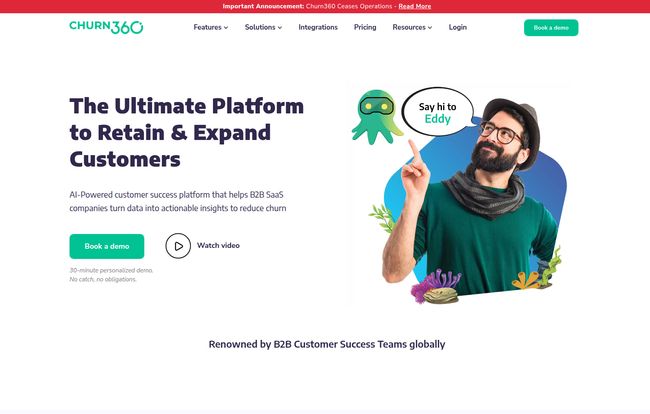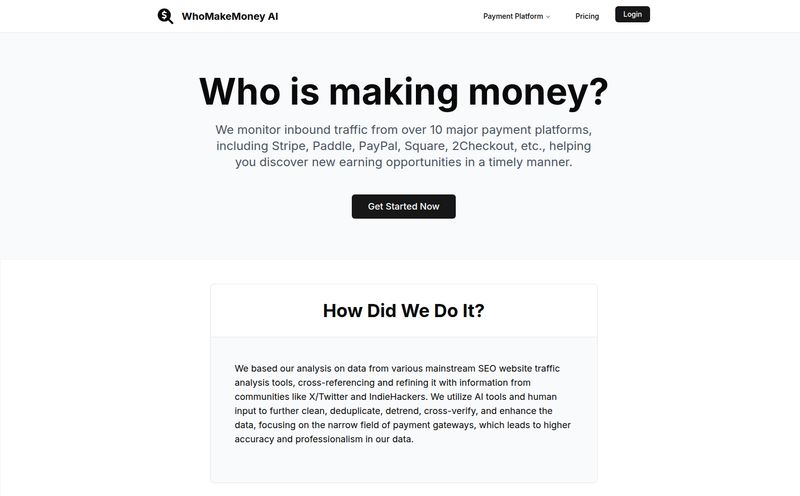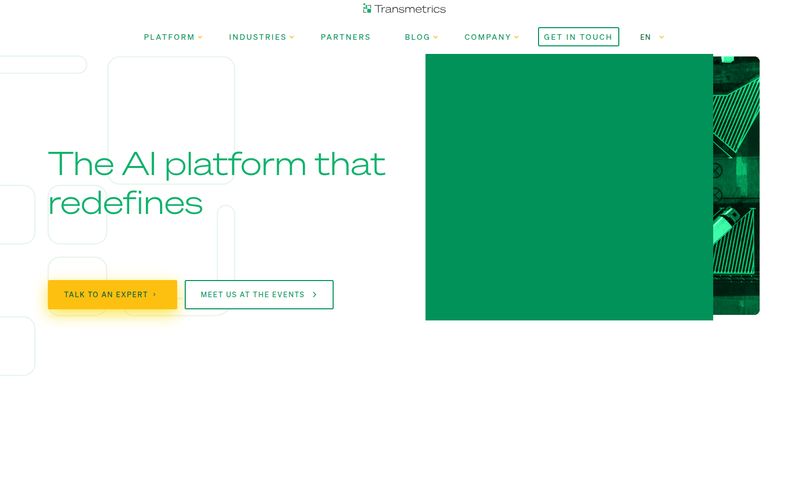There’s a quiet graveyard where SaaS tools go to rest. We’ve all seen it. A promising platform pops up, generates some buzz, maybe we even bookmarked it to check out later… and then, poof. Gone. The latest headstone in that digital cemetery belongs to a tool I had my eye on: Churn360.
If you head to their site now, you’re not greeted by flashy graphics or promises of ROI. Instead, you'll find a simple, stark announcement: “Churn360 Ceases Operations.” It’s a gut-punch, not just for the team that built it, but for anyone in the SaaS world who understands the monumental effort behind creating such a product.
But this isn't going to be a somber obituary. Instead, let's do a proper post-mortem. Let's look at what Churn360 was, the problem it tried to solve, and most importantly, what its journey can teach us about the wild world of customer success.
So, What Was Churn360 Anyway?
At its heart, Churn360 was trying to be the mission control for B2B SaaS customer success teams. Its whole reason for being was to tackle the sneakiest, most silent killer of subscription businesses: customer churn.
Ever feel like you’re trying to piece together a customer's story from a dozen different apps? You've got support tickets in Zendesk, payment history in Stripe, conversations in Slack, and CRM data in HubSpot. It’s a mess. You’re basically a detective trying to solve a case with clues scattered across the entire city.
Churn360’s big promise was to bring all those clues into a single, unified dashboard. It was an AI-powered platform designed to give you a genuine, all-encompassing view of your customers, so you could stop being reactive and start being proactive. A pretty noble cause, if you ask me.
The Ambitious Toolkit It Offered
Looking at what they built, it’s clear the team had a deep understanding of what a Customer Success Manager (CSM) actually needs. It wasn't just a dashboard; it was an arsenal of tools.

Visit Churn360
The All-Seeing Eye: A 360° Customer View
This was the cornerstone. The idea was to integrate with all your existing software—your CRM, billing platform, helpdesk, etc.—and pull all that data into one place. This created a single source of truth for each customer. No more tabbing between five different systems just to figure out if a client is happy or about to walk.
Predicting the Future with Health Scores
This is where the AI part really came into play. Churn360 would analyze all that unified data—product usage, support ticket frequency, survey responses, payment history—to generate a “health score.” It was like a credit score for customer loyalty. A low score was a flashing red light, a warning sign that you needed to intervene before that dreaded cancellation email landed in your inbox. It was about reading the digital tea leaves to prevent problems.
Automating Success with Plays and Campaigns
A health score is useless if you don't act on it. Churn360 included “Plays,” which were essentially automated workflows. For instance, if a customer’s health score dipped, a Play could automatically trigger a task for their CSM to check in, or send an automated email with helpful resources. It was about making customer success scalable and repeatable, not just dependent on heroic, last-minute saves.
They also had tools for customer journey tracking—mapping out key stages like onboarding, adoption, and renewal—and managing targeted communication campaigns. It was a comprehensive suite aimed at turning customer success from an art into a science.
The Elephant in the Room: The Shutdown
For three years, the team at Churn360 built this impressive product. And then, on May 15th, 2024, they made the call to shut it down.
What makes this story different is the why. In a refreshingly transparent note on the company’s website, founder Saravana Kumar (of Kovai.co fame) explained the decision. It wasn’t a matter of running out of money. It was something deeper. He wrote:
“I made the decision based on this one simple principle: ‘Invest based on Merit, not based on Affordability.’ As a bootstrapped company, we had the financial runway to keep going for another few years. But it didn't feel like it was the right thing in everyone's best interest.”
Wow. Take a moment to appreciate that. He goes on to explain that they couldn't see a clear path to break even or scale dramatically. Instead of letting it slowly wither, they made the tough, courageous call to shutter it. That takes guts. It’s a powerful lesson in entrepreneurial integrity—knowing when to fold, not because you're forced to, but because it's the right strategic move.
Why Do Great SaaS Tools Sometimes Fail?
Churn360’s story is a microcosm of the challenges facing so many SaaS companies today. The customer success space, in particular, is incredibly crowded. You’re competing with established giants like Gainsight and relative newcomers like Catalyst. It's a real cage match out there.
Building a platform that relies heavily on integrations, as Churn360 did, is also a double-edged sword. While integrations provide immense value, they also create a massive technical overhead and dependency on other platforms' APIs. Keeping all those connections stable and up-to-date is a herculean task.
And sometimes, despite having a great product and a solid team, you just can’t find that magical, elusive product-market fit at a scale that makes the business viable. It’s a brutal reality of the market. Sometimes, you can build a fantastic car, but if you can't build a factory that can produce it efficiently and profitably, it remains a brilliant prototype.
So, What's the Takeaway For the Rest of Us?
Even though Churn360 is gone, its ghost offers some valuable lessons for anyone in the SaaS or marketing game.
- The Mission is Still Critical. The need for what Churn360 was trying to do hasn't vanished. Unifying customer data to get a single, coherent view is more important than ever. Its demise doesn't invalidate the problem; it just highlights how hard it is to solve.
- Proactive Beats Reactive, Every Time. The core concepts of health scoring and automated plays are the future of customer management. We should all be thinking about how to implement these ideas, whether with another tool or through our own internal processes. Don't wait for the fire alarm; install smoke detectors.
- Integrity Over Ego. The way the Churn360 team handled the shutdown is a masterclass. The transparency and the principle-driven decision-making are something to admire and, frankly, emulate. Knowing when to stop is as important as knowing when to start.
In the end, we can raise a glass to Churn360. A good idea, a solid effort, and a graceful exit. It’s a reminder that not every venture ends in a billion-dollar valuation, and that’s okay. There’s honor in building something useful and even more honor in knowing when to say, “That’s a wrap.”
Frequently Asked Questions about Churn360
- What was Churn360?
- Churn360 was an AI-driven Customer Success platform for B2B SaaS companies. It aimed to reduce customer churn by providing a 360-degree view of customers, automated workflows, and predictive health scores.
- Why did Churn360 shut down its operations?
- According to its founder, the decision to cease operations in May 2024 was a strategic one based on the principle of investing in products with merit and a clear path to scale. It wasn't due to a lack of funding, but rather a tough call about the product's long-term viability and ability to break even.
- Who was the founder of Churn360?
- Churn360 was founded by Saravana Kumar, who is also the founder of the successful bootstrapped company Kovai.co. His experience and transparency were key elements in the platform's story.
- Are there any good alternatives to Churn360?
- Yes, the customer success space has several strong players. Some popular alternatives include Gainsight, Catalyst, ChurnZero, and Planhat. Each has its own strengths, so you'd need to evaluate them based on your specific business needs and budget.
- What is a customer health score?
- A customer health score is a metric used to predict a customer's likelihood to grow, renew, or churn. It's typically calculated by combining various data points, such as product usage, support interactions, survey results, and contract value, into a single, representative score.
A Final Thought
The SaaS world moves fast, and not every player can finish the race. But the ideas and lessons from platforms like Churn360 contribute to the industry's collective wisdom. They tried to solve a real, painful problem, and for that, they deserve our respect. On to the next innovation.
Reference and Sources
- The official Churn360 website for the shutdown announcement: www.churn360.com
- The parent company behind Churn360: Kovai.co
- Founder Saravana Kumar's story on LinkedIn regarding the decision (as referenced on the announcement page).



